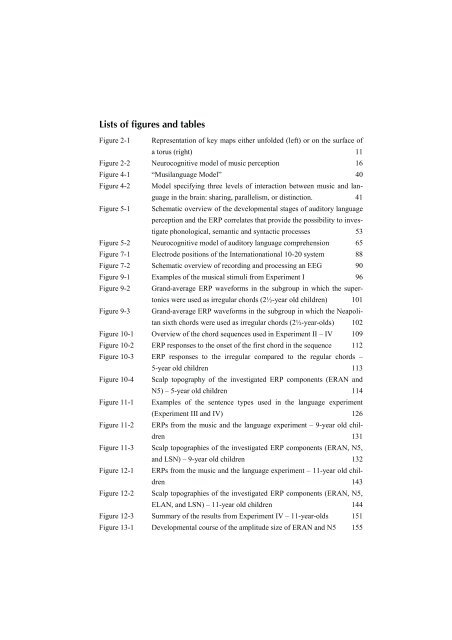Neural Correlates of Processing Syntax in Music and ... - PubMan
Neural Correlates of Processing Syntax in Music and ... - PubMan
Neural Correlates of Processing Syntax in Music and ... - PubMan
You also want an ePaper? Increase the reach of your titles
YUMPU automatically turns print PDFs into web optimized ePapers that Google loves.
Lists <strong>of</strong> figures <strong>and</strong> tables<br />
Figure 2-1 Representation <strong>of</strong> key maps either unfolded (left) or on the surface <strong>of</strong><br />
a torus (right) 11<br />
Figure 2-2 Neurocognitive model <strong>of</strong> music perception 16<br />
Figure 4-1 “Musilanguage Model” 40<br />
Figure 4-2 Model specify<strong>in</strong>g three levels <strong>of</strong> <strong>in</strong>teraction between music <strong>and</strong> language<br />
<strong>in</strong> the bra<strong>in</strong>: shar<strong>in</strong>g, parallelism, or dist<strong>in</strong>ction. 41<br />
Figure 5-1 Schematic overview <strong>of</strong> the developmental stages <strong>of</strong> auditory language<br />
perception <strong>and</strong> the ERP correlates that provide the possibility to <strong>in</strong>vestigate<br />
phonological, semantic <strong>and</strong> syntactic processes 53<br />
Figure 5-2 Neurocognitive model <strong>of</strong> auditory language comprehension 65<br />
Figure 7-1 Electrode positions <strong>of</strong> the Internationational 10-20 system 88<br />
Figure 7-2 Schematic overview <strong>of</strong> record<strong>in</strong>g <strong>and</strong> process<strong>in</strong>g an EEG 90<br />
Figure 9-1 Examples <strong>of</strong> the musical stimuli from Experiment I 96<br />
Figure 9-2 Gr<strong>and</strong>-average ERP waveforms <strong>in</strong> the subgroup <strong>in</strong> which the supertonics<br />
were used as irregular chords (2½-year old children) 101<br />
Figure 9-3 Gr<strong>and</strong>-average ERP waveforms <strong>in</strong> the subgroup <strong>in</strong> which the Neapolitan<br />
sixth chords were used as irregular chords (2½-year-olds) 102<br />
Figure 10-1 Overview <strong>of</strong> the chord sequences used <strong>in</strong> Experiment II – IV 109<br />
Figure 10-2 ERP responses to the onset <strong>of</strong> the first chord <strong>in</strong> the sequence 112<br />
Figure 10-3 ERP responses to the irregular compared to the regular chords –<br />
5-year old children 113<br />
Figure 10-4 Scalp topography <strong>of</strong> the <strong>in</strong>vestigated ERP components (ERAN <strong>and</strong><br />
N5) – 5-year old children 114<br />
Figure 11-1 Examples <strong>of</strong> the sentence types used <strong>in</strong> the language experiment<br />
(Experiment III <strong>and</strong> IV) 126<br />
Figure 11-2 ERPs from the music <strong>and</strong> the language experiment – 9-year old children<br />
131<br />
Figure 11-3 Scalp topographies <strong>of</strong> the <strong>in</strong>vestigated ERP components (ERAN, N5,<br />
<strong>and</strong> LSN) – 9-year old children 132<br />
Figure 12-1 ERPs from the music <strong>and</strong> the language experiment – 11-year old children<br />
143<br />
Figure 12-2 Scalp topographies <strong>of</strong> the <strong>in</strong>vestigated ERP components (ERAN, N5,<br />
ELAN, <strong>and</strong> LSN) – 11-year old children 144<br />
Figure 12-3 Summary <strong>of</strong> the results from Experiment IV – 11-year-olds 151<br />
Figure 13-1 Developmental course <strong>of</strong> the amplitude size <strong>of</strong> ERAN <strong>and</strong> N5 155












